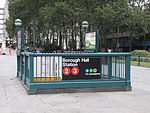Montague–Court Building

The Montague–Court Building is a 35-story, 462 ft (141 m) tall commercial office tower at 16 Court Street in Downtown Brooklyn, New York City. It was designed by architect H. Craig Severance and built in 1927. It is the tallest office building and the twelfth tallest building overall in Brooklyn at 462 feet (141 m). The building is 35 stories tall and has a floor area of 317,625 ft² (29,508 m²). The Montague–Court building is currently owned and managed by the CIM Group, which purchased it from SL Green Realty in 2017 for $171 million. In February 2012, the New York City Landmarks Preservation Commission designated the building as part of the Borough Hall Skyscraper Historic District.
Excerpt from the Wikipedia article Montague–Court Building (License: CC BY-SA 3.0, Authors, Images).Montague–Court Building
Montague Street, New York Brooklyn
Geographical coordinates (GPS) Address External links Nearby Places Show on map
Geographical coordinates (GPS)
| Latitude | Longitude |
|---|---|
| N 40.693611111111 ° | E -73.990833333333 ° |
Address
Montague-Court Building
Montague Street
11201 New York, Brooklyn
New York, United States
Open on Google Maps









